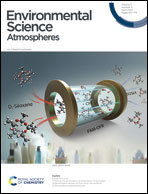Pros and cons of wood and pellet stoves for residential heating from an emissions perspective†
Abstract
Biomass burning is a growing alternative to fossil fuels for power generation. Small-scale residential wood combustion introduces air pollutants to local populated areas compared to remote, large-scale facilities. Pellet fuel appliances are an alternative to log burning as they are considered more efficient; however, as emissions are not as well characterized, comparative studies to establish the potential benefits of increased pellet stove usage is required. Here we describe a distinction in optical and chemical properties of emissions from a residential pellet and a log-burning stove using state-of-the-art online measurements. Specifically, we report the first online simultaneously phase-resolved semi-volatile organic measurements from such appliances, using a Time of Flight Chemical Ionisation Mass Spectrometer with a Filter Inlet for Gas and AEROsols (FIGAERO-ToF-CIMS). Pellet particle emissions were 90% brown carbon-containing substituted mono-aromatic compounds (SMAs) whereas wood emissions contained equal black carbon (BC) and organic carbon (OC) and contained 3–55 times more poly-aromatic hydrocarbons (PAHs). Lowering pellet fuel loadings increased OC and SMA emission factors (EFOC and EFSMA), therefore increasing particle mass as well as optical absorption, i.e. “brownness”. The consequence of these EF differences is illustrated for a hypothetical national burden assuming a base case 10 : 1 log to pellet stove energy demand usage and a ‘swapped’ demand to simulate increased pellet stove usage. This results in net decreases of PM and BC burdens by 12% and 42% respectively but is somewhat offset by a 57% increase in OC burden. Changes in phase resolved speciated organic EFs suggest the reduction in particle burdens is somewhat offset by increases in gas burdens for some organic species, which could contribute to delayed particle burdens through secondary aerosol formation.



 Please wait while we load your content...
Please wait while we load your content...